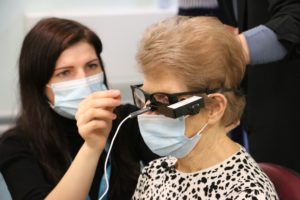Revolutionary bionic chip inserted in Moorfields patient’s blind eye

A patient from Moorfields Eye Hospital NHS Foundation Trust has been able to detect signals in her blind left eye thanks to a revolutionary new implant. She is the first UK patient to receive this new device, as part of a Europe-wide clinical trial. It offers the hope of partially restored vision for people with geographic atrophy (GA), the most common form of dry age-related macular degeneration (AMD).
The procedure involves inserting a 2mm wide microchip under the centre of a patient’s retina, by surgically creating a trapdoor into which the chip is posted. The patient uses special glasses, containing a video camera that is connected to a small computer attached to their waistband.
The chip captures the visual scene projected by the glasses and transmits this to the computer. Artificial intelligence (AI) algorithms process this information and instruct the glasses to focus on what it perceives to be the main object in the image. The glasses project this image as an infra-red beam through the eye to the chip, which converts this into an electrical signal. This signal passes through the retina cells and optical cells into the brain, where it is interpreted as if it were natural vision.
Four to six weeks after being inserted, this implant is tested by switching the chip on, and at this stage the patient should be able to see a signal. They then go through a rehabilitation programme to learn how to use the vision they have been given. After this, patients are potentially able to recognise words when they couldn’t before.
It is being trialled with patients who have lost their vision in an eye because of GA. This condition is progressive and currently has no treatment. 12% of those over 80 will be affected by dry AMD, while GA affects 6.7% of over 80s.
An 88-year-old women with seven children and eight grandchildren, was the first UK patient to benefit from this implant. “Losing the sight in my left eye through dry AMD has stopped me from doing the things I love, like gardening, playing indoor bowls and painting with watercolours. I am thrilled to be the first to have this implant, excited at the prospect of enjoying my hobbies again and I truly hope that many others will benefit from this too.”
Mahi Muqit, consultant vitreoretinal surgeon at Moorfields Eye Hospital, honorary clinical lecturer at the UCL Institute of Ophthalmology, and National Institute of Health Research (NIHR) research investigator“This groundbreaking device offers the hope of restoration of sight to people suffering vision loss due to dry AMD. The success of this operation, and the evidence gathered through this clinical study, will provide the evidence to determine the true potential of this treatment.”
This research is supported by the NIHR Biomedical Research Centre at Moorfields Eye Hospital NHS Foundation Trust and UCL Institute of Ophthalmology.
The Prima System device used in this operation was developed by Pixium Vision in France.
For further information, please contact Gordon.harrison3@nhs.net
Join our mailing list
If you would like to receive regular news and updates about our work, then you can sign up to our mailing list.
